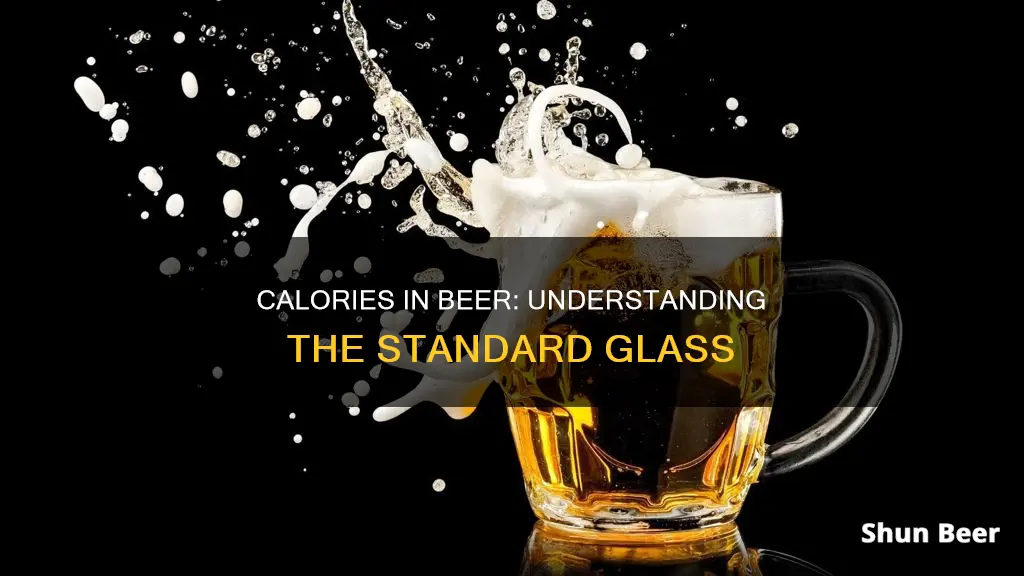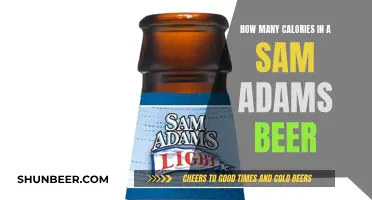
Beer is a popular drink worldwide, but it's also a drink that's high in calories. The number of calories in a beer depends on the type of beer, its alcohol content, and the serving size. A typical 12-ounce beer with 4% ABV contains about 150 calories, but this can vary greatly depending on the specific beer. Beers with higher alcohol content tend to have more calories, and craft beers can have even more. While the occasional beer won't make you gain weight, regularly consuming more calories than you need can lead to weight gain. Understanding the calorie content of beer and practising mindful drinking can help individuals make informed choices about their consumption.
What You'll Learn

Alcohol and carbs are the main sources of calories in beer
Beer is made from fermented grain, and the calories in beer come mainly from carbs and alcohol. The number of calories in beer depends on the alcohol content and, to a lesser extent, the carb content. A typical 12-ounce beer has around 140 calories, which is similar to a can of Coke. Some beers have twice as many calories.
The calorie content of beer varies widely, depending on the type of beer and its alcohol and carb content. Light beers with very low alcohol content (2% to 3% alcohol) such as Miller 64 have around 60 calories in a 12-ounce serving. Most light beers (4% alcohol) have about 100 calories. Bud Light Next has 80 calories and achieves this by reducing both the alcohol and carb content to zero. Budweiser, a regular 5% alcohol beer, has around 150 calories.
IPAs, double or imperial IPAs, and Belgian-style Trippels are heavy hitters with 7% to 11% alcohol content and pack 200 to 300 calories in a 12-ounce serving. A lower-alcohol "session" IPA reduces the calorie count to about 140. Newer "lo-cal" IPAs like Dogfish Head Slightly Mighty contain as few as 100 calories.
The calorie count increases significantly when served in larger glasses. A 16- or 20-ounce draft pour of an average beer contains 200 to 250 calories.
Craft, seasonal, and high-alcohol beers tend to have more calories than lighter beers. Alcohol-free options usually contain fewer calories.
Canadian Beer Calories: How Many in a Glass?
You may want to see also

Beer is considered empty calories due to its low nutritional value
A standard 12-ounce beer contains around 140 calories, which is similar to the amount in a can of Coke. However, some beers can contain up to 280 calories, depending on their alcohol content and other factors.
The fermentation process used to make beer involves starches and sugars, which are significant sources of empty calories. On average, these sugars and starches contain a similar number of calories per gram as pure fat. While ancient beers may have had more nutritional value, modern refining processes have stripped beer of most nutrients, leaving only trace amounts of certain vitamins and minerals that can be obtained from other food sources.
The high number of empty calories in beer can contribute to weight gain and malnutrition, especially when consumed in excess. This is because when the body is processing alcohol, it prioritises removing the toxin from the body over burning fat or absorbing nutrients. As a result, the breakdown and storage of other nutrients are disrupted, which can lead to a build-up of fatty substances in the liver, causing liver disease if drinking continues.
To reduce calorie intake, individuals can opt for low-calorie or non-alcoholic beers, which usually contain fewer calories while still providing a similar taste and experience. Moderation is also key, and it is recommended that men consume no more than two alcoholic beverages per day, while women should limit themselves to one.
Calorie Count in Smithwick's Beer: Nutritional Facts
You may want to see also

A 12-ounce beer with 4% ABV has about 150 calories
The calories in beer come primarily from alcohol and carbohydrates. About 60% of the calories come from alcohol, and the remaining 40% come from carbohydrates. A higher alcohol content will result in more calories. For example, an average 5% alcohol beer has around 150 calories, while heavy hitters with 7%-11% alcohol can have 200-300 calories.
Compared to other alcoholic drinks, beer tends to have a higher number of calories. For instance, a typical 12-ounce beer has as many calories as a can of Coke (around 140). However, beer doesn't have much nutritional value, which is why it is often referred to as "empty calories."
If you're watching your calorie intake, there are a few strategies to consider. Firstly, opt for lower-alcohol beers, as these will have fewer calories. Secondly, try alternating alcoholic drinks with non-alcoholic ones to reduce your overall calorie consumption. Finally, drinking less beer overall is an effective way to cut down on calories.
Calories in Stag Beer: What's the Count?
You may want to see also

IPAs tend to have a high alcohol content and calorie count
The calorie content of beer depends on several factors, including alcohol content, serving size, and brand. A typical 12 oz. beer has around 140 calories, but this can vary between 60 and 300 calories depending on the alcohol content.
IPAs tend to have a high alcohol content and, as a result, a high calorie count. A regular 12 oz. beer has 155 calories, whereas an IPA of the same serving size can range from 170 to 240 calories. This is due to the higher amount of hops or malt in the beer mixture. The more hops in a beer, the higher the calorie count.
Some IPAs have an even higher alcohol content, such as double IPAs, which typically have an alcohol content of 7.5%, and imperial IPAs, which have 10% or more alcohol. These IPAs will have an even higher calorie count.
However, there are also low-calorie IPAs available, which have the same alcohol content as session IPAs but with fewer calories. These beers typically have an ABV of under 5% and can have as few as 95 calories.
While IPAs tend to have a high alcohol content and calorie count, it's important to remember that the specific calorie content will depend on the brand and serving size. Additionally, consuming beer in moderation and being mindful of portion sizes can help manage calorie intake.
Calories in Beer: Understanding the Nutritional Breakdown
You may want to see also

Beer calories can be calculated using ABV% x 2.5 x ounces of beer
The calories in a beer depend on its alcohol and, to a lesser extent, its carbohydrate content. The higher the ABV, the more calories a beer will have. This is because each gram of alcohol in beer contains about seven calories.
You can calculate the calories in a beer using the formula: ABV% x 2.5 x ounces of beer. For example, a 16-ounce serving of beer with an ABV of 6% would be estimated to contain approximately 240 calories.
A typical 12-ounce beer has around 140 calories, which is similar to a can of Coke. Beers with higher alcohol content, such as IPAs, can contain 200-300 calories.
Light beers tend to have fewer calories, often with minimal flavour compromise. A light beer with 2-3% ABV has around 60 calories, while those with 4% ABV have approximately 100 calories.
Non-alcoholic beers usually contain fewer calories, and they also have some health benefits.
Calories in Radler Grapefruit Beer: A Healthy Option?
You may want to see also
Frequently asked questions
The number of calories in a beer depends on the size of the serving, the type of beer, and its alcohol content. A typical 12-ounce beer that is 4% ABV has about 150 calories.
About 60% of calories in beer come from alcohol and 40% from carbohydrates. Beer with a higher alcohol content will generally have more calories.
Beer tends to be higher in calories than wine and spirits. A typical 12-ounce beer has as many calories as a can of Coke (140).
Yes, you can opt for low-calorie beers, which tend to have a low ABV, or non-alcoholic beers, which usually contain fewer calories. You can also try drinking less, alternating with non-alcoholic drinks, or drinking at a slower pace.







